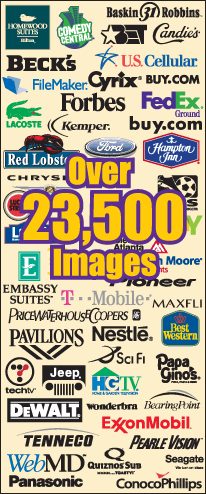Frequently asked questions
Q: How do I apply vinyl graphics?
This is one of the most frequently asked questions. It's easy! Every order is different, and an instruction sheet is shipped with each order to help you with your specific project.
Q: How do I remove old or unwanted vinyl graphics?
It is best to use a heat gun or a hair dryer to encourage the release of the adhesive and prevent the vinyl from "snapping" when it is pulled with force. Try to be gentle and take your time when removing vinyl.
Many customers report great results using gasoline to remove any leftover adhesive residue that is exposed once the vinyl graphics are removed. This is not recommended for many surfaces, however, as it may damage the finish.
Q: What exactly are vinyl graphics?
Vinyl graphics are individually-cut letters or logos. These are the types of designs that appear to look like painted graphics at first, but are actually made of vinyl. Vinyl graphics are durable, versatile, and perfectly cut (better than any painter could ever do!). You find them on many signs, windows, commercial vehicles, boats, and airplanes.
The term 'vinyl graphics' now includes any adhesive-backed vinyl decal, including those that have color images printed on them.
Q: What are vinyl graphics used for?
Vinyl graphics are ideal for almost any application, indoors or out, that could use paint. Check out our products section to see a few examples of vinyl graphics in action.
Q: What resolution or file format should I send my artwork in?
If you are sending artwork for us to print directly from, here are the formats we accept, in order of preference:
- CorelDraw 10-12
- Photoshop
- TIF (Zipped or LZW-compressed, please)
- JPG
- GIF
- Adobe Illustrator
File formats we cannot accept:
- Paint Shop Pro
- MS Publisher
- WordPerfect Document
- Powerpoint Presentations
- Macintosh SIT files, (please use PKZip or 7-ZIP)
For image files such as Photoshop, TIFs, and JPGs, we prefer the following resolutions:
- Banner: 60-90 DPI at 1:1 size
- Car Wrap: 60-90 DPI at 1:1 size
- Small Decal: 90-360 DPI at 1:1 size
- Large Decal: 60-180 DPI at 1:1 size
- Poster Print: 90-360 DPI at 1:1 size
"Blowing up" a low-quality image to a higher resolution just to increase the DPI is not going to produce a quality print. If you have a low-resolution image you may want to send it to us and ask us if it can be printed at your desired size.
If you can obtain the original line-art file / PSD file used by most designers, we can print your logo with maximum quality. If not, you may need to find a higher-quality image or recreate the artwork; we can help.
Q: Will the vinyl graphics I order from you match the exact color shown on my screen?
Color matching is done to the best of our ability. Due to the infinite configuration possibilities of end-user hardware and software, it is impossible to perfectly match the digital proof that is provided. All proofs are understood to be close representations of the printed product, and will inevitably have a certain degree of deviance from a monitor's display. If you require an exact match, a physical printed proof can be delivered to you for $30 + shipping.
Q: Can you apply the graphics to a sign for me?
We can apply your graphics for you if you are local, or if the sign is reasonably easy to ship. Our banners, small signs, and magnetic signs come with vinyl graphics already applied. Contact us if you need anything else and we'll get it done!
Q: What exactly is a car wrap, and how much do they cost?
The cost of a vehicle graphics package is largely based on two factors: The size of the vehicle, and the type of graphics to be applied.
There are two main types of graphics that are widely used on vehicles -- solid-color vinyl, and full-color digital prints. Solid-color vinyls are ideal for logos that do not incorporate gradient fills, (fades). For example, it would be easy to reproduce a simple two- or three-color logo in solid-color vinyl. However, for photographic images, and fading gradient fills, the digital printing process can achieve the effect by printing the image onto a durable white vinyl. This process is excellent for photographic images, graphics with drop shadows, fading fills, and many other effects. However, this is also slightly more expensive than the traditional solid-color vinyls.
When designing vehicle graphics, striking a tasteful and effective balance between these two types of graphics can save hundreds of dollars. Not only are we willing to help you determine what the best options are for your budget, but we are also willing to help you design your graphics from the ground up -- absolutely free of charge. In order to handle serious inquiries only, we require a non-refundable 20% deposit which will be applied to the total purchase price once the artwork is approved.
Solid-color vinyls are versatile and inexpensive compared to the digitally- printed, full-color graphics -- which range in price from about $8 - $16 per square foot, depending on the material used and the ink coverage. You can expect moderate coverage graphics for a mid-size car that employs solid- color graphics to be around $500 to $700, whereas the digitally-printed, photographic wrap for the same vehicle may cost around $2000 to $2500.
Our goal is to make vehicle graphics affordable and easy -- a target price of less than $1500 on most packages makes our prices far less than the competition -- and our service is the best in the industry. Also, if you have taken the time to price a radio or TV ad, which only lasts a few days, you will soon realize that this is by far the most economical and cost-effective way to advertise, and continues to work for you every day!
If you have any additional information regarding the graphics, including any images, text or logos that you intend to use in the design, please forward it in your reply to this email.
Q: How is a car wrap applied?
A car wrap is a large vinyl decal. It has many unique advantages over paint, in that it can be removed and changed out later without affecting the vehicle's body. Car wraps allow you to temporarily change the appearance of the vehicle, but allow you to return it to its original condition. It is important to note that it is not paint. A vinyl wrap cannot adhere to porous, textured, or rubbery materials such as window and body molding; moving parts such as hinges; greasy or dirty areas, etc. All vinyl manufacturers require a 1/4" separation from those areas to ensure proper contact with the body of the vehicle. Additionally, the vinyl panels are flat and can be molded to conform to gradual slopes and bends, but complex curves may require patching, overlaying or relief cuts -- all of which should be difficult or impossible to see from a reasonable distance, (say 10 feet). The notion that a wrap can provide 100% total coverage of all cracks and crevices is not accurate. The materials used to create a wrap are outdoor durable, and carry a lifetime expectancy of 1-3 years. However, the climate, treatment, and washing of the wrap are factors beyond the limits of the manufacturer and the installer. Contact us for more information!
Q: How should I prepare my car wrap artwork?
Ideally, we prefer a Photoshop file that contains digital pictures of each side of the vehicle with the graphics laid over it.
If you want to make life easy, we recommend doing the following: Take a snapshot of each side of the vehicle with a 3' yardstick somewhere in the picture, (say, laying on the ground). This ensures exact scaling to the size of the vehicle. Make certain that none of the pictures are from an angle or have a "fish-eye" effect of making the center of the image appear larger. This also prevents any uncertainty regarding the variations among certain models and years. Then draw your graphics on a separate layer in Photoshop.
As for DPI, if the image is 1:1, then 60 to 90 DPI is usually sufficient, but sometimes our customers prefer to supply up to 180 DPI. This will yield better print quality, but is usually unnecessary unless the vehicle is to be parked at a trade show or other event under close scrutiny.
We will try to cut the image in panels that correspond to the vehicle's door seams if you can supply a PSD file that contains digital pictures, as described above. RGB is preferred.


